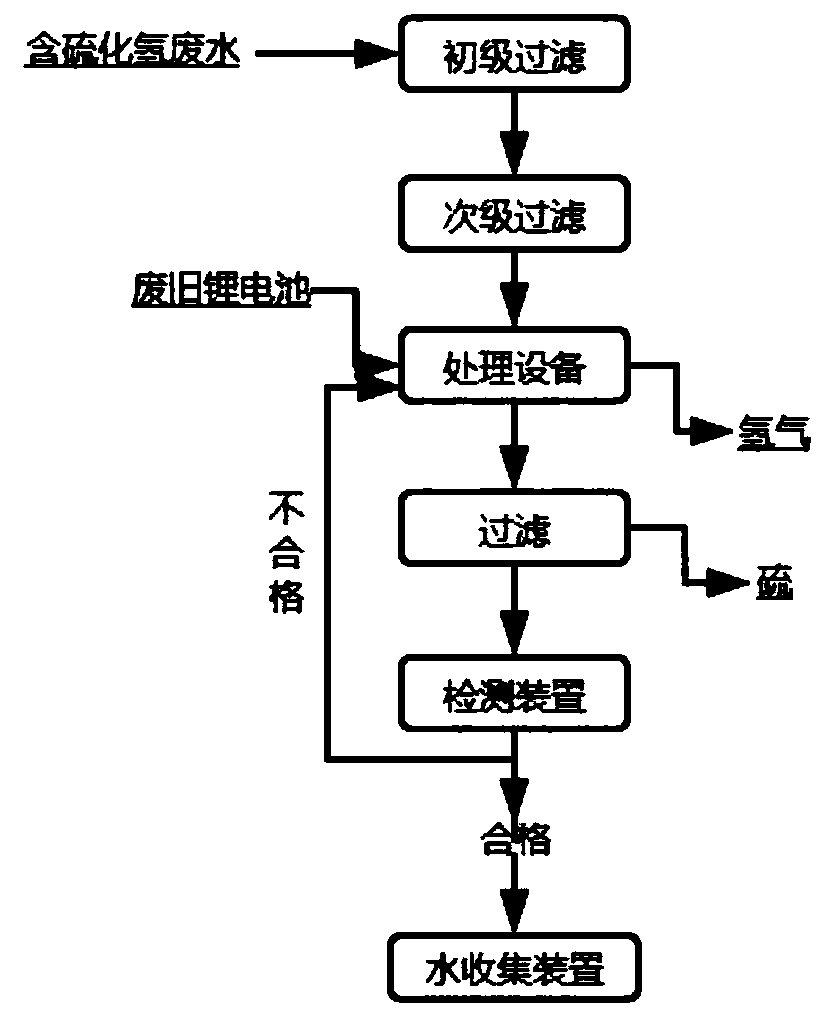A combined treatment method for waste battery discharge and sulfur-containing wastewater desulfurization
A waste battery, combined treatment technology, applied in gaseous discharge wastewater treatment, multi-stage water treatment, water/sewage treatment, etc. The discharge time is shortened and the effect of cascade utilization is realized
- Summary
- Abstract
- Description
- Claims
- Application Information
AI Technical Summary
Problems solved by technology
Method used
Image
Examples
Embodiment 1
[0048] Such as figure 1 Shown, the present invention is a kind of method for the hydrogen sulfide in waste water that the residual energy cascade utilization in a kind of battery, industrial waste water (in the waste water, the existence form of sulfur is S 2- and HS - , the total mass fraction of sulfur is at 9.6wt.%) through the primary filter to remove the suspended matter with a particle size greater than 0.5mm in advance; then carry out secondary filtration, add an adsorbent during the secondary filter and centrifugally filter to remove the suspended matter with a particle size less than 0.5mm A secondary filtrate was obtained. The pH value of the secondary filtrate is about 7.3 (7.3 ± 0.1), and the secondary filtrate is sent to the reaction device equipped with waste lithium batteries (soaking the waste lithium batteries in the secondary filtrate) for discharge treatment. The generated gas is collected to obtain high-purity hydrogen, and after sufficient time to react,...
Embodiment 2
[0054] Take 10L of industrial waste water, and after primary filtration and secondary adsorption filtration, the sulfur content of the secondary filtrate without suspended solids is determined to be 9.6wt.%. Then pour the secondary filtrate into a closed device with waste batteries. The initial voltage of the waste batteries is 3.8-3.85V. Add sulfuric acid to adjust the pH value of the filtrate to about 1. At this time, the sulfur in the solution is 2 S, HS- exists in the form. After 24 hours of discharge, the sulfur content was determined to be 0.73wt.%, the average residual voltage of the waste battery was around 0.5V, and the gas composition in the gas collection device was analyzed to find that the hydrogen gas fraction was 73%, and the hydrogen sulfide volume fraction was 25%. It can be seen that hydrogen sulfide gas is released in acidic environment.
Embodiment 3
[0056] Take 10L of industrial waste water, and after primary filtration and secondary adsorption filtration, the sulfur content of the secondary filtrate without suspended solids is determined to be 9.6wt.%. Then pour the secondary filtrate into a closed device containing waste batteries, the initial voltage of which is 3.8-3.85V. Add sodium hydroxide to adjust the pH value of the filtrate to about 10 (10 ± 0.1). 2- form exists. After 24 hours of discharge, the sulfur content was determined to be 0.13wt.%, the average residual voltage of the waste battery was around 0V, the gas composition in the gas collection device was analyzed and the hydrogen gas fraction was 98%, and no hydrogen sulfide gas was detected. It can be seen that no hydrogen sulfide gas is released under alkaline environment.
PUM
| Property | Measurement | Unit |
|---|---|---|
| particle diameter | aaaaa | aaaaa |
Abstract
Description
Claims
Application Information
 Login to View More
Login to View More - R&D
- Intellectual Property
- Life Sciences
- Materials
- Tech Scout
- Unparalleled Data Quality
- Higher Quality Content
- 60% Fewer Hallucinations
Browse by: Latest US Patents, China's latest patents, Technical Efficacy Thesaurus, Application Domain, Technology Topic, Popular Technical Reports.
© 2025 PatSnap. All rights reserved.Legal|Privacy policy|Modern Slavery Act Transparency Statement|Sitemap|About US| Contact US: help@patsnap.com

